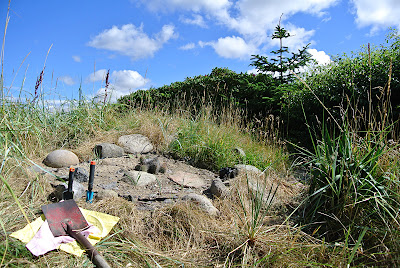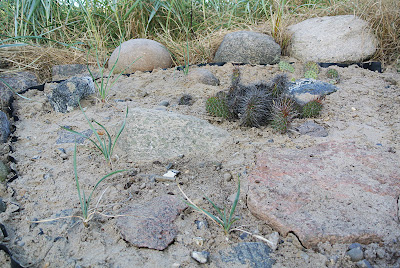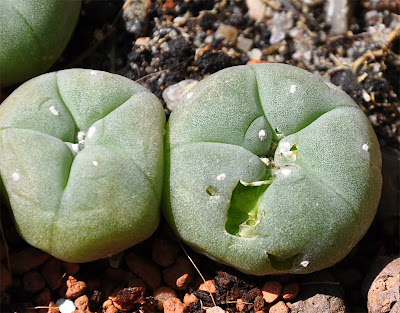As mentioned in the previous post my wife and I spent a couple of days of our summer vacation reclaiming a winter-hardy cactus bed at our summerhouse, situated at the northern west coast of Denmark. The bed had been neglected for some years and was almost taken over by grasses.

Winter-hardy cactus bed - half of which is still overgrown by grasses
At the beginning of the second day we were still missing half of the bed. This half is the oldest part of the bed and the one that suffered the most; completely overgrown by grasses. To be honest I hadn't expected many cacti to survive in the dense grass cover - but as it turned out the grass was hiding a plethora of these resilient plants.

Recovering winter-hardy Opuntia cacti from the dense grass cover
Especially Opuntia humifusa and Opuntia 'Smithwick' turned out to be growing in large numbers - the latter to an extent so that we had to call on the help of my nephews old, sun bleached toy wheelbarrow to hold all the Opuntia 'Smithwick' plants we recovered from the grasses.

Reclaimed winter-hardy cactus bed
After several hours our job was done and we could finally declare the bed completely reclaimed from the grasses. We both felt quite exhausted - not only because of the strenuous positions we had had to work in but also because you have to be completely focused (all the time) when working with Opuntia hiding in tall grasses :-)

Overview of the newly reclaimed part of the Opuntia cactus bed
The following plants are growing in the newly reclaimed part of the winter-hardy Opuntia cactus bed:
Top center: Opuntia humifusa
Top right: Opuntia 'Claude Arno'
Bottom left: Opuntia fragilis
Bottom center: Opuntia polyacantha
Bottom right: Opuntia 'Smithwick'
The plants at the top left are Opuntia trichophora v. nova (Roswell, New Mexico) growing in the part of the bed that was reclaimed the day before.
Saturday, August 31, 2013
Reclaiming my winter-hardy cactus bed - day 2
Tuesday, August 13, 2013
Reclaiming my winter-hardy cactus bed - day 1
Several years ago I started growing winter-hardy cacti in open air beds at my summerhouse in the northwestern part of Denmark.

Neglected winter-hardy cactus bed almost taken over by grasses
I have neglected the beds badly for the past three years and consequently they were almost taken over by Leymus and other grasses, and several of the cacti plants have died. Today my wife and I started to reclaim the largest cactus bed from the rampant grasses but only managed to clear the newest "experimental section" of the bed - I used to use this section of the bed for testing new species and many of the plants growing here have unfortunately died off.
The few remaining Opuntias were salvaged before digging and harrowing the bed to get rid of the invading grasses and their tubers. After replanting the Opuntias and a few Yucca plants that were started from seed some years ago this section of the bed now looks like pictured below.

Reclaimed and replanted cactus and yucca bed
The two plants at the top left are Yucca glauca (Yuma County, Colorado) while the three at the front left are Yucca neomexicana (JRT 251; Cimmeron County, Oklahoma). The center plant is an Opuntia hystricina cultivar named 'Hanau' and finally the plants at the top right are Opuntia trichophora v. nova (Roswell, New Mexico).
We'll continue salvaging the remaining part of the bed tomorrow.
Friday, August 02, 2013
Peyote plants maimed by birds
As mentioned in the post "Growing peyote (and other cacti) on the balcony" I'm experimenting with growing peyote cacti in window flower boxes on my balcony.

Peyote cactus maimed by a bird
The plants are thriving outdoors basking in the Danish summer sun, but several times I've had to chase blackbirds and pigeons off of the flower boxes. Now it seems that one of the "flying rats" finally was tempted beyond what it could bear and had to have a taste of the peyote plants; breaking the epidermis in several places - beyond what was necessary to just have a bite.

Bird damaged peyote in flower box
I've always found the intrusive pigeons annoying but now I consider them pests.
Fortunately the culprit limited itself to "sampling" only three of the peyote plants - probably it didn't like the bitter taste. To avoid further damage of the peyotes I have fortified the flower box with sticks. Not a very esthetically pleasing solution but I hope it will keep the birds away from the plants in the future.

Fortified flower box with peyote and Acharagma
All Time Most Popular Posts
-
Lophophora williamsii (peyote) populations have diminished in large areas of South Texas where peyoteros harvest the cactus for ceremonial ...
-
On various occasions I've been asked what growing media I'm using for my cactus plants. I don't have a set soil mix recipe as su...
-
Below is a list of retailers/nurseries selling cactus seed and plants. I've only listed vendors I've done business with. If you ar...
-
Most cacti are easily grown from seed - and with a little patience and care they can be grown into beautiful plants. Lophophora williamsi...
-
In last month’s post on the troubled Texan peyoteros I referred to Anderson’s article on the peyote situation in Texas. Given the importanc...
-
Yet another slightly off topic and probably not entirely politically correct post, but I couldn’t help noticing the similarity of my monstr...
-
Flowering stand of San Pedro cacti (Trichocereus pachanoi) To me the main draw of the San Pedro cactus ( Trichocereus pachanoi (syn. Ech...
-
In the June 2008 issue of the Cactus & Co magazine Jaroslav Šnicer, Jaroslav Bohata, and Vojtěch Myšák described a new Lophophora spec...
-
There seems to be an increased focus on the alarming Texas peyote situation. A couple of weeks ago the Houston Press published a mournful, i...
-
I spent two weeks working in Delhi, India during January. I had one weekend off and had planned to spend it in Delhi at my own leisure, but ...


















